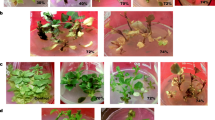Abstract
Three alternate exposures of Cicer arietinum (gram) root callus to lethal (1 ppm) endosulfan-containing selective medium (SM) and non-selective medium (NSM) yielded a tolerant cell line (1 ESR). Such an induced resistance was retained during subculture on NSM for 15 generations tested so far. Higher soluble proteins and peroxidase activity were found in 1 ESR compared to mother tissue.
Similar content being viewed by others
References
Hughes K (1983) Selection for herbicide resistance. In: Sharp WR, Ammirato PV, Yamada Y (eds) Hand Book of plant cell culture. Macmillan, New York pp 442–460
Thomas E, King PJ, Potrykus I (1979) Improvement of crop plants via single cell in vitro An assessment. Z Pflanzenzuchtg 82: 1–30
Chaleff RS (1980) Further characterisation of picloram tolerant mutants of Nicotiana tabaccum. Theor Appl Genetics 58: 91–95
Hughes KW, Negrotto D, Daube ME, Meeusen RL (1984) Free radical stress response in paraquat sensitive & resistant tobacco plant. Env Exp Bot 24: 151–157
Chaleff RS, Ray TB (1984) Herbicides resistant mutants from tobacco cell cultures. Science 223: 1148–1151
Aviv D, Galun E (1977) Isolation of tobacco protoplast in presence of Isopropyl N-phenyl carbamate and their cultures and regulation into plants. Z Pflanzenphysiol 83: 267–273
Chaleff RS, Keil RL (1981) Genetics and physiological variability among cultured cells and regenerated plants of Nicotiana tabaccum. Mole Genet 181: 254–258
Maier-Bode H (1968) Properties, effects, residues and analytics of insecticide endosulfan. Res Rev 22: 1–44
Agarwal S, Beg MU (1982) Effect of endosulfan on the endogenous IAA, cell wall polysaccharides, peroxidase activity and its isoenzymatic pattern in germinating Cicer arietinum seeds. Ind J Exp Biol 20: 319–323
Agarwal S, Beg MU (1982) Biochemical changes in Cicer arietinum seedlings on exposure to endosulfan. Ind J Biochem & Biophys 19: 247–252
Trivedi BS, Beg MU, Gupta RC (1983) Evaluation of endosulfan for its phytotoxic properties. Ind J Bot Soc 62: 393–398
Agarwal S, Beg MU, Krishna Murti CR (1983) Suppression of auxin stimulated growth of barley coleoptile sections by endosulfan. J Biosci 5: 85–86
Farooq M, Beg MU (1985) Effect of endosulfan technical and EC-35 preparation on the permeability of Rhoeo discolor leaf. Pesticides 19 (5): 44–45
Daneil CS, Agarwal S, Agarwal SS (1986) Human red blood cell membrane damage by endosulfan. Toxicol Lett 32: 113–118
Gamborg OL, Miller RA, Ojima K (1968) Nutrient requirement of suspension cultures of soyabean root cells. Exp cell Res 50: 151–158
Lowry OH, Rosebrough NF, Farr AL, Randall RJ (1951) Protein measurement with Folin-phenol reagent. J Biol Chem 193: 265–275
Srivastava AK, Azhar S, Krishna Murti CR (1972) Inhibition of germination of Cicer arietinum. Phytochem II: 3181–3185
Chaleff RS, Parson MF (1978) Direct selection in vitro for herbicide resistant mutants of Nicotiana tabaccum. Proc Nat Acad Sci USA 75 (10): 5104–5107
Barg R, Umiel N (1977) Development of tobacco seedlings and callus cultures in presence of amitrol. Z Pflanzenphysiol 83: 437–447
Zenk MJ (1974) In: Kasha KJ (ed) Haploids in higher plants University of Guelph Press Guelph Ontario pp 339–353
Kochba J, Spiegel-Roy P, Saad S (1980) Selection for tolerance to sodium chloride (NaCl) and 2,-dichlorophenoxy acetic acid (2,4-D) in ovular callus lines of Citrus sinensis. In: Sala F, Parisi B, Cella R, Ciferri O (eds) Plant cell cultures: Results and Perspectives. Elseviers North Holland Biomedical Press, Amsterdam pp 187–192
Maliga P, Marton L, Sr Brenovits A (1973) 5-Bromodeoxyuridine resistant cell line from haploid tobacco. Pl Sci Lett 1: 375–383
Cole D (1983) Oxidation of xenobiotics in plants. In: Huston DH, Roberts TR (Eds) Progress in Pesticide Biochemistry and Toxicology Vol 3, John Wiley & Sons pp 199–254
Author information
Authors and Affiliations
Rights and permissions
About this article
Cite this article
Saxena, R.P., Beg, M.U. Selection of endosulfan-tolerant gram cell line. Plant Cell Tiss Organ Cult 12, 273–277 (1988). https://doi.org/10.1007/BF00034368
Issue Date:
DOI: https://doi.org/10.1007/BF00034368




